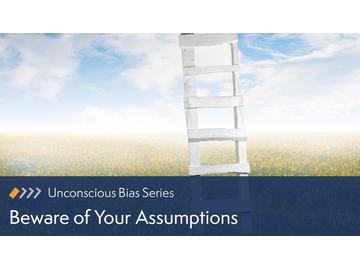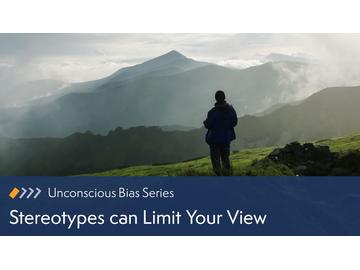Unconscious Bias Series
Keywords: unconscious bias, diversity, equity, Inclusion, Emotional Intelligence, critical thinking
Related Courses

Critical Thinking: Making the Case for Critical Thinking
Visited 897 times
$5.95

Critical Thinking: Being an Agile Critical Thinker
Visited 1,017 times
$5.95
Unconscious Bias Series

Our brains are so infinitely complex, we’re not even aware of most of the processes that are constantly occurring, but one of those processes could be contributing to unconscious bias, along with a mess of other bad habits. Fortunately, there’s a way to address and correct this automatic response system. In this course, you’ll learn how to correct habits and impulses by utilizing your top-down brain to correct and redirect your bottom-up brain.
Objectives:
- Identify your bottom-up responses and how they can affect your daily life
- Use critical thinking to manage your bottom-up responses
- Correct bad habits and unnecessary impulses with top-down practices
Course Features: Audio Narration, Video, Job Aids and Reference Materials

- Identify the motivating elements in your life
- Recognize the cognitive biases that arise from those motivations
- Make more satisfying choices without resorting to negative biases

- Determine whether your self-perception matches how others perceive you
- Ask the right questions of the right people to get an accurate picture
- Identify opportunities to make your self-perception more closely match how others see you

Making assumptions is a completely natural behavior, but it can lead to beliefs and even actions that we would not have come to if we had all the information, and that practice can cause much undue anxiety and stress. Use critical thinking skills to acknowledge and resist assumptions to quiet your biases and save yourself some energy and anxiety.
Objectives:
- Recognize the temptation to make assumptions
- Learn the ladder of inference and how it can affect your life
- Redirect yourself to avoid assumptions and diminish your biases
Course Features: Audio Narration, Video, Job Aids and Reference Materials

Mental short cuts go by many different names. They happen when you react or make a decision without considering all the information you have available. Instead, you might consider only the most recently-received information. What happens when you react without enough information is that your biases have much more influence over your decisions. Learn to identify and avoid mental shortcuts to lessen the influence of your biases.
Objectives:
- Recognize when you’re taking a mental short cut
- Identify situations where you use mental shortcuts
- Begin to minimize your unconscious bias by avoiding short cuts
Course Features: Audio Narration, Video, Job Aids and Reference Materials

Today’s society is rampant with stereotypes. Stereotypes are based on the idea that individuals within a group must hold similar characteristics. Virtually everyone has them, but most people are ashamed to admit it, which makes them difficult to explore and resolve. Stereotypes can create biases depending on how your stereotypes fit in with the people and information around you.
Objectives:
- Be aware of stereotypes held against you to gain perspective on the stereotypes you hold
- Question yourself and explore where your stereotypes might have come from
- Learn new ways to relate to all people without acting on stereotypes or bias
Course Features: Audio Narration, Video, Job Aids and Reference Materials

- Identify the use of biases in supporting your own beliefs, actions, ideas, and decisions
- Become more self-aware in order to manage your bias and adapt more effectively
- Start taking the time to think things through more carefully to avoid biased reactions

We’re all guilty of bias, but it can be dangerous if left unchecked. Practicing self-awareness and admitting that you might have your own bias is a crucial step in reducing the effect bias has on your decision-making and relationship-building. Once you’ve identified your bias, work toward changing the way you think as a habit.
Objectives:
- Examine your thoughts and actions to identify your own bias
- Apply three mental tools to check and manage your bias
- Continue addressing any bias you identify to successfully break bad habits
Course Features: Audio Narration, Video, Job Aids and Reference Materials

Biases show up in our actions and words, which can be an issue when you’re trying to solve a problem or pitch an idea. Biases prevent us from thoroughly examining the idea before reacting. Then we develop support around the reaction instead of choosing our reaction based on what idea or solution has the most support. By rephrasing or hearing the idea or problem from other perspectives, you can help minimize thought errors and get to the best possible result.
Objectives:
- Challenge yourself to tell your stories in different ways to eliminate bias
- Work alone or with your friend or your team to put different perspectives on your story
- Explore ideas more thoroughly and reach better, more complete solutions
Course Features: Audio Narration, Video, Job Aids and Reference Material

- Learn how optimism can work to your advantage is some situations and not in others
- Adopt a more positive and in-control mindset in your daily life
- Make positive outcomes more likely to happen by taking control of those situations

Buy This Course
Price :
$59.95 ( Per License )
Resold modules appear on your website. You earn syndication share from each purchase. Contact Coggno to learn more on how to embed your own Portable Webshop in your website.